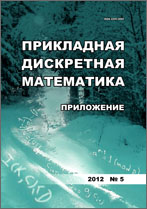|
|
Prikladnaya Diskretnaya Matematika. Supplement, 2014, Issue 7, Pages 76–78
(Mi pdma165)
|
 |
|
 |
Mathematical Methods of Steganography
A new highly accurate approach to non-distorted bitmap images quantitative steganalysis
V. A. Monarev
Institute of Computing Technologies, Siberian Branch of the Russian Academy of Sciences, Novosibirsk
Abstract:
The problem of detecting information, embedded into non-distorted bitmap images (such as bmp, pgm, tiff etc.) via LSB-replacement and LSB-matching methods (the latter is also known as $\pm1$-steganography) is considered. There are two main approaches to address this problem in contemporary steganalysis: ordinary and quantitative. The first one is aimed at finding out only a fact of the embedding, while the second one tries to estimate a volume of the embedded information. The mostly widespread quantitative methods for detecting LSB-replacement are RS-analysis, Sample Pairs analysis, WS-steganalysis and Improved WS steganalysis. One more, a so-called shift-method, is especially effective for color images. The enlisted methods allow to detect the embedding up to 0.01 bits-per-pixel (bpp) depending on the image (in particular, noisy images are more difficult to analyse). There are no effective quantitative methods for detecting $\pm1$-steganography, therefore, the most popular ones are ordinary methods Support Vector Machine and Linear Discriminant Analysis, which are able to detect up to 0.1 bpp. These methods are also can be applied to LSB-replacement and are able to detect the embedding up to 0.01 bpp. In the current paper, a new scenario and a new quantitative method within this scenario are suggested. The scenario assumes that a Warden knows exact pixels, where the information is supposed to be embedded, and it can be implemented, for instance, in the following situation. Assume that the Warden is given a device which is used for the information embedding (a key can be already injected into it). The task is to detect whether a given image has some embedded information via this device, or not. It is experimentally shown that the new method allows to detect up to 0.001 bits-per-pixel embedding, that is much more than known methods.
Keywords:
steganalysis, LSB-replacement, LSB-matching, embedding rate.
Citation:
V. A. Monarev, “A new highly accurate approach to non-distorted bitmap images quantitative steganalysis”, Prikl. Diskr. Mat. Suppl., 2014, no. 7, 76–78
Linking options:
https://www.mathnet.ru/eng/pdma165 https://www.mathnet.ru/eng/pdma/y2014/i7/p76
|

| Statistics & downloads: |
| Abstract page: | 320 | | Full-text PDF : | 166 | | References: | 42 |
|




 Contact us:
Contact us: Terms of Use
Terms of Use
 Registration to the website
Registration to the website Logotypes
Logotypes








 Citation in format
Citation in format 